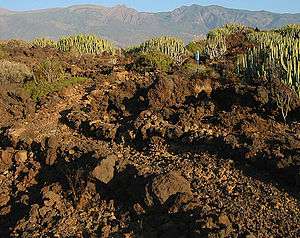Malpaís (landform)
Malpaís is a term used in the Southwestern United States, Spain, Mexico, and other Spanish-speaking regions for a rough and barren landscape that consists of relict and largely uneroded lava fields exhibiting recognizable lava flows, volcanic cones, and other volcanic landforms. This type of volcanic landscape is extremely rough and difficult to traverse. It is characteristic of an arid environment because in more humid climates, lava fields are quickly destroyed by weathering and erosion.
While the term describes many xeric places, it is strongly associated with Spanish-speaking countries and the Southwestern United States, where Spanish settlers named this landform.[1][2]
Badlands landform
The word 'malpaís' in Spanish translates to "badland," and this describes the area as being extremely rough and difficult to traverse and unusable for crops. Although a malpaís is often another word for the badlands that form by erosion of sedimentary rocks in the same environment, a malpaís is often associated with such types of lava plain terrain as found in a volcanic field. The geology of malpaís terrain is bare to thin layers of soil over lava with sparse vegetation. The lava fields usually consist of lava tube systems, sinkholes, pyroclastic deposits from cinder cone volcanoes, and ʻaʻā and pāhoehoe lava flows. The lava tubes can vary from intact caves to partial or completely collapsed passages. The collapsed tubes, sinkholes, and jagged ʻaʻā surfaces are what make malpaís terrain so difficult to navigate and cultivate, thereby earning their name.[3]
Examples
El Malpaís National Monument is an example of this landform in New Mexico.[4] Other examples are the Carrizozo Malpaís and Jornada del Muerto Volcano lava plain, in the Tularosa Basin's Jornada del Muerto Desert. The Malpaís de Güímar is an example in the Spanish Canary Islands.
Etymology
A loanword from Spanish, malpaís is in wide use in English in the southwest United States. The literal translation of malpaís is "badland." Other Spanish terms for badlands are tierras baldías and cárcava.
References
- Strahler, A. N., 1970, Introduction to Physical Geography, 2nd ed. John Wiley and Sopns. New York, New York. 486 pp. ISBN 978-0471831686
- Neuendorf, K.K.E., J.P. Mehl, Jr., and J.A. Jackson, eds. (2005) Glossary of Geology (5th ed.). Alexandria, Virginia, American Geological Institute. 779 pp. ISBN 0-922152-76-4
- Rogers, Bruce. "General Geology and Development of Lava Tubes In New Mexico's El Malpais National Monument" (PDF). Retrieved 7 October 2013.
- "El Malpais National Monument - (U.S. National Park Service)". www.nps.gov.
| Look up malpaís in Wiktionary, the free dictionary. |
